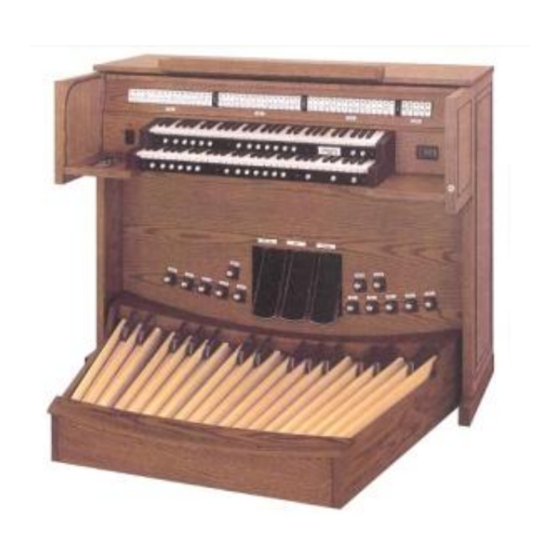
Table of Contents
Advertisement
Quick Links
Quick Start:
1. Turn organ on
2. Using the Console Controller on the far left, select memory 15 (for preludes and postludes) or 16 (for congregational
singing). To do so, push the Cursor button until curser is flashing on the number next to the MEM. Use the dial to
choose the desired memory number.
3. Select one of the push button (pistons) labeled 1-5 and 6-10 found to your left under the two sets of keys (manuals).
Piston 1 is the softest set of registrations and 10 is the loudest on memory 16.
Manual: This term is synonymous with keyboard.
Swell refers to the organ's upper manual and Great to
the lower manual.
Division: The organ has three main divisions: Swell,
Great and Pedal. The Swell and Great divisions' stops
are played from their respective manuals. The Pedal
division is played from the organ's pedal keys.
Stops: The controls that actuate the organ's various
sounds. The AP-22a's stops are located above the Swell
manual and are arranged according to the organ's three
divisions.
Couplers: In addition to stops which produce sound,
the organ also has a variety of couplers that allow
sounds to be played from manuals other than that of
their resident division. (i.e. Swell stops may be played
on the Great manual by using the Swell to Great
coupler.) Couplers are found to the right of each
division's stops.
Expression Pedals (Shoes) – The AP-22a is equipped
with three shoes or large pedals set into the base of the
organ's body. The leftmost shoe controls ("expresses")
the volume of the Great and Pedal divisions' stops. The
center shoe adjusts the volume of the Swell stops. Bar
graph indicators to the right of the manuals indicate
each shoe's position.
Crescendo Pedal (Shoe) – The rightmost of the three
shoes set into the base of the organ's body. Depressing
this shoe turns on the stops of the organ in a
predetermined sequence from "softest to loudest,"
producing a gradual "crescendo" of sound. Use this
rarely and cautiously, perhaps when accompanying the
Allen Organ Model AP-22a
QUICK REFERENCE GUIDE
choir. One of the bar graph indicators indicates the
crescendo shoe's position.
Pistons – These controls, located beneath each
keyboard and above the pedal keys, are divided into the
following categories:
1. General Thumb Pistons – round buttons located
2. Divisional Thumb Pistons – located beneath the
3. General Toe Studs – these silver-colored knobs are
4. Pedal Division Toe Studs – control only pedal stops.
5.
6. Coupler Toe Studs – are duplicates of the coupler
7. Crescendo B Piston – causes the crescendo shoe to
under the left portion of the manuals, these pistons,
numbered 1 through 10, control the stops of the
entire instrument.
middle of each manual, these pistons, numbered 1
through 6, control only the resident stops of that
division. (i.e. The divisional pistons directly beneath
the Swell manual control only the Swell stops of the
organ, etc.)
duplicates of the general thumb pistons that have
the same numbers. General toe studs are located
to the left side of the expression shoes and are
labeled 6-10.
These are located to the right of the crescendo shoe
and are labeled 1-5.
Coupler Pistons – located next to the divisional
thumb pistons, they are duplicates of the coupler
stops on the stop rail that have the same name.
GT/PD is to the left of manuals and SW/GT is to the
right. Note that the coupler pistons and toe studs
are "reversible." That is, pressing them can either
turn the couplers on or off.
pistons.
produce an alternate sequence of stops from
softest to loudest. It is "reversible."
Advertisement
Table of Contents

Summary of Contents for Allen Organ Company AP-22a
- Page 1 1 through 10, control the stops of the Stops: The controls that actuate the organ’s various entire instrument. sounds. The AP-22a’s stops are located above the Swell 2. Divisional Thumb Pistons – located beneath the manual and are arranged according to the organ’s three middle of each manual, these pistons, numbered 1 divisions.
- Page 2 Hymn Player’s operation. left side of the Great manual. While holding the Set For further instructions please refer to the AP-22a Owner’s Manual and the Preset Organ Registrations sheet located in your organ’s bench or available online at LDS.org.



Need help?
Do you have a question about the AP-22a and is the answer not in the manual?
Questions and answers